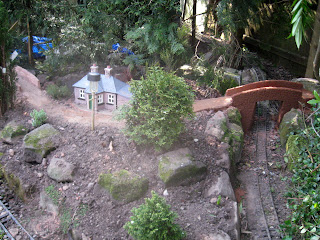 With the onset of Spring and some leave booked over Easter, it was time to tame the garden. In addition to pruning a few of the more energetic shrubs and giving the lawn its first trim, time was found to do some detailing of the railway. A couple of the station buildings have been fixed in place, a road has been constructed with two overbridges, a corner has been re-landscaped and a roadside cottage sited.
With the onset of Spring and some leave booked over Easter, it was time to tame the garden. In addition to pruning a few of the more energetic shrubs and giving the lawn its first trim, time was found to do some detailing of the railway. A couple of the station buildings have been fixed in place, a road has been constructed with two overbridges, a corner has been re-landscaped and a roadside cottage sited.The road and cottage
 The cottage is a pottery model made by Stanton Abbey Pottery. This model is of a canalside cottage but I felt it looked like a toll-cottage, hence its position beside the road. The owner of the pottery, Robert Silkstone, contacted me after I placed the order to ask for my preferred colour scheme and I so I asked for the stonework to be matched to the local sandstone. The quality of finish is quite impressive.
The cottage is a pottery model made by Stanton Abbey Pottery. This model is of a canalside cottage but I felt it looked like a toll-cottage, hence its position beside the road. The owner of the pottery, Robert Silkstone, contacted me after I placed the order to ask for my preferred colour scheme and I so I asked for the stonework to be matched to the local sandstone. The quality of finish is quite impressive.This corner of the garden lies within a triangle of track near Bulkeley Station. After digging it over and relocating some of the conifers, I dug a trench for the road (see How I made a road) and for the base of the cottage. Coloured concrete was poured into the trench on a foundation of rubble and the cottage was carefully positioned while the concrete was wet. I have heard that models which are securely fixed in place are covered by household insurance whereas those which are removeable are not.
Overbridges
Two overbridges have been cast in concrete in situ. Rather than constructing them from ply, I decided to go for something more durable - besides, I like working with concrete (see How I cast two concrete overbridges).

 Station buildings
Station buildingsSo far, two station buildings have been fixed in place. A concrete base was cast for the building at Bulkeley which was modified from a children's toy (see How I made a station building from a £5.50 toy) in a similar way to that for the cottage. It was raised to plaform height and given jigstones slabs for the plaform edging. To fix the building in place, a piece of 4"x 3/4" timber was cut to length to fit snugly inside the building. This was then screwed to the concrete plinth with rawlplugs. Brass screws were then screwed into the wooden block through the sides of the building. If you look closely at the photo below, you can see one of the screws to the right of the steps leading up to the door.
 A similar approach was used to fix the station building into place at Beeston Market. Again, the screws can be seen either side of the Robin starch advert. These will be touched-up with paint.
A similar approach was used to fix the station building into place at Beeston Market. Again, the screws can be seen either side of the Robin starch advert. These will be touched-up with paint. This building was constructed from a T&M Models kits (see How I assembled the station buildings).
This building was constructed from a T&M Models kits (see How I assembled the station buildings).
No comments:
Post a Comment